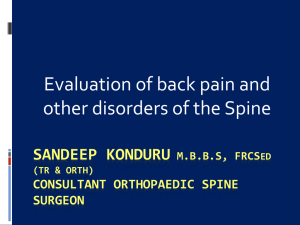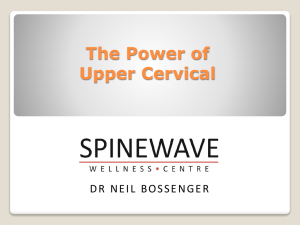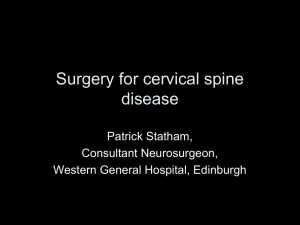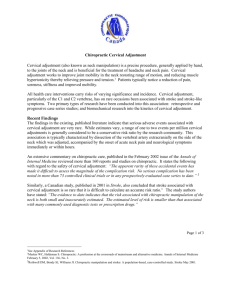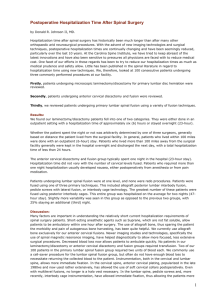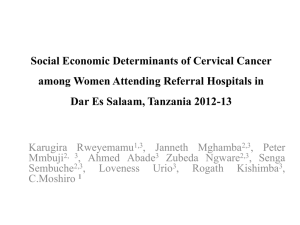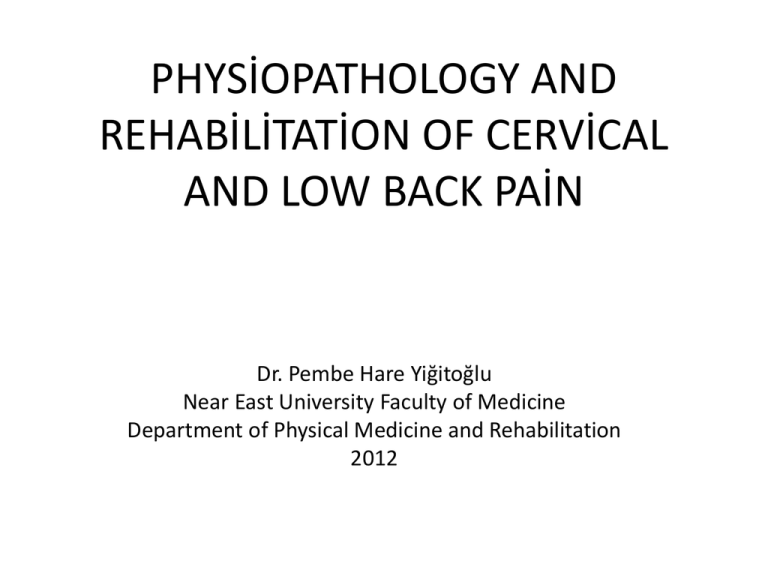
PHYSİOPATHOLOGY AND
REHABİLİTATİON OF CERVİCAL
AND LOW BACK PAİN
Dr. Pembe Hare Yiğitoğlu
Near East University Faculty of Medicine
Department of Physical Medicine and Rehabilitation
2012
• Low back and neck pain are second only to the
common cold as the most common affliction
of mankind.
• Low back and neck pain are symptoms, not
diseases, and they have many causes.
• The symptom of axial skeleton pain is
associated with a wide variety of mechanical
and systemic disorders.
• Mechanical disorders cause the vast majority
of low back or neck pain episodes.
• Most of these mechanical disorders resolve
over a short period of time.
Disorders affecting the low back and
neck
•
•
•
•
•
•
•
•
Mechanical
Rheumatologic
Endocrinologic/Metabolic
Neurologic/Psychiatric
Infectious
Neoplastic/Infiltrative
Hematologic
Referred pain
LOW BACK PAİN
• Low back pain has become a leading cause of
disability and loss of productivity.
• It is extremely common.
• About 40% of people say that they have had
low back pain within the past 6 months.
• Studies have shown a lifetime prevalence as
high as 84%.
• Most patients have short attacks of pain that
are mild or moderate and do not limit
activities.
Red flags (Risk Factors for Secondary
LBP Due to Important Pathologies)
• Back pain in children <18 y with considerable
pain or onset >55 y
• History of violent trauma
• Mild trauma in an aged patient
• Constant progressive pain at night
• History of cancer
• Systemic steroids
• Drug abuse, human immunodeficiency virus
infection
Red flags (Risk Factors for Secondary
LBP Due to Important Pathologies)
•
•
•
•
•
•
•
Weight loss
Systemic illness
Persisting severe restriction of motion
Intense pain with minimal motion
Structural deformity
Difficulty with micturition
Loss of anal sphincter tone or fecal incontinence;
saddle anesthesia
• Progressive motor weakness or gait disturbance
Red flags (Risk Factors for Secondary
LBP Due to Important Pathologies)
• Inflammatory disorders (ankylosing
spondylitis) suspected
• Gradual onset <40 y
• Marked morning stiffness
• Persisting limitation of motion
• Peripheral joint involvement
• Iritis, skin rushes, colitis, urethral discharge
• Family history
Mechanical disorders of the
lumbosacral spine
•
•
•
•
•
•
Back strain
Lumbar disc herniation
Lumbosacral spondylosis
Lumbar spinal stenosis
Spondylolisthesis
Scoliosis
Back strain
• Back strain is preceded by some traumatic event
that can range from coughing to lifting a heavy
object.
• Muscle strain is acute back pain that radiates up
the ipsilateral paraspinous muscles, across the
lumbar area, and sometimes caudally to the
buttocks without radiation to the thigh.
• No neurologic abnormalities are present.
Lumbar disc herniation
• The disc's structure is composed of outer annulus
fibrosus and inner nucleus pulposus.
• The nucleus pulposus have regions with highly
hydrophilic.
• The hydrated nucleus within the annulus acts as a
shock absorber to cushion the spinal column from
forces that are applied to the musculoskeletal system.
• Nuclear material is normally contained within the
annulus, but it may cause bulging of the annulus or
may herniate through the annulus into the spinal canal.
• Neurologic examination may reveal sensory
deficit, asymmetry of reflexes, or motor
weakness corresponding to the damaged
spinal nerve root.
• More than 95% of lumbar disk herniations
occur at the L4–L5 and L5–S1 levels
Lumbosacral spondylosis
• Osteoarthritis of the lumbosacral spine may
cause localized low back pain.
• Oblique views of the lumbar spine
demonstrate facet joint narrowing,
periarticular sclerosis and osteophytes.
Lumbar spinal stenosis
• The narrowing of the spinal canal that occurs in
stenosis results from the degenerative changes.
• Neurologic claudication is the most common
presenting symptom of lumbar stenosis.
• It is classically described as bilateral leg pain initiated
by walking, prolonged standing, and walking downhill
(relative lumbar extension).
• It is typically relieved by sitting or bending forward.
Spondylolisthesis
• Lumbar spondylolisthesis is the anterior
displacement of a vertebral body in relation to
the underlying vertebra.
• Spondylolisthesis usually is secondary to
degeneration of intervertebral discs.
• The most common level affected in a
degenerative slip is the L4–L5 level.
Scoliosis
• Scoliosis is a lateral curvature of the spine in
excess of 10°.
• Most commonly begins to develop in
adolescent girls.
Cancer and Low Back Pain
• The spine is the most common site for bony
metastases.
• Vertebral body metastases are found in more than one
third of cancer patients.
• The most common cancers that involve the spine are
–
–
–
–
lung,
breast,
prostate,
renal cell.
Spinal Infections
• Spinal infections include
– osteomyelitis,
– diskitis,
– pyogenic facet arthropathy,
– epidural infections.
• It is important to diagnose and treat spinal
infections quickly
– to prevent increased morbidity and mortality,
– to prevent complications such as epidural
abscesses that can cause paralysis.
Spondyloarthropathies
• Spondyloarthropathies are a group of diseases
associated with the HLA-B27 allele.
• They include
– Ankylosing spondylitis,
– Reactive arthritis,
– Psoriatic arthritis,
– Enteropathic arthritis,
– Undifferentiated spondyloarthropathy.
Ankylosing Spondylitis
• Ankylosing spondylitis is the prototype for the
spondyloarthropathies.
• It generally first presents with morning
stiffness and a dull ache in the low back or
buttocks.
Rehabilitation
• Patient Education
– Education should include providing as much of an
explanation as patients need in terms they can
understand.
• Back Schools
– The term back school is generally used for group
classes that provide education about back pain.
– They include information about the anatomy and
function of the spine, common sources of low back
pain, proper lifting technique and ergonomic training,
and sometimes advice about exercise and remaining
active.
• Exercise
– Exercise results in positive outcomes in the
treatment of chronic low back pain.
– The most effective exercise for low back pain
includes an individualized regimen learned and
performed under supervision that includes
stretching and strengthening.
– Patients who have not tolerated land-based
exercises are often able to participate in pool
exercises.
Medication
•
•
•
•
Nonsteroidal Antiinflammatory Drugs
Muscle Relaxants
Antidepressants (Tricyclic antidepressants)
Topical Treatments (Lidocaine patches,
antiinflammatory creams)
• Injections and Needle Therapy for Mechanical
Low Back Pain
– Myofascial Pain and Trigger Point Injections
– Acupuncture
– Steroid Injections and Other Spinal Procedures
• Lumbar Supports
• Superficial and deep heat
• Transcutaneous Electrical Nerve Stimulation
– The stimulation of large afferent fibers inhibits
small nociceptive fibers, causing the patient to
feel less pain.
• Lumbar epidural steroid injections have become a
common adjuvant for the treatment of
lumbosacral radiculopathy.
• Surgical management of lumbosacral
radiculopathy is best reserved for those patients
who have
– significant persistent symptoms despite 6 to 8 weeks
of maximized conservative management,
– neurologic progression or
– cauda equina syndrome.
CERVİCAL PAİN
• The prevalence of neck pain with or without
upper limb pain ranges from 9% to 18% of the
general population.
• One of three individuals can recall at least one
incidence of neck pain in their lifetime.
Mechanical disorders of the cervical
spine
•
•
•
•
•
Neck strain
Cervical disc herniation
Cervical spondylosis
Myelopathy
Whiplash
Neck strain
• Neck strain is rarely associated with a specific
trauma.
• It is typically triggered by sleeping in an awkward
position, turning the head rapidly.
• Physical examination reveals local tenderness in
the paracervical muscles, with decreased range of
motion and loss of cervical lordosis.
• No abnormalities are found on neurologic
examination.
Cervical disc herniation
• Intervertebral disc herniation in the cervical
spine causes radicular pain that radiates from
the shoulder to the forearm to the hand.
• Neurologic examination may reveal
– sensory deficit,
– asymmetry of reflexes,
– motor weakness corresponding to the damaged
spinal nerve root.
Cervical spondylosis
• Osteoarthritis of the cervical spine
• As the disc degenerates, the articular structures
are brought closer together, the cervical spine
becomes unstable.
• Increased instability results in osteophyte
formation.
• Plain radiographs show the intervertebral
narrowing and facet joint sclerosis.
Myelopathy
• The most serious sequelae of cervical spondylosis
is myelopathy.
• This disorder occurs as a consequence of spinal
cord compression by
– osteophytes,
– ligamentum flavum or
– intervertebral disc.
• Clinical symptoms include weakness and
uncoordination in the hands.
• In the lower extremities, this disorder can
cause
– gait disturbances,
– spasticity,
– leg weakness and
– spontaneous leg movements.
• Sensory deficits include decreased
dermatomal sensation and loss of
proprioception.
• Hyperreflexia, clonus and positive Babinski’s
sign are present in the lower extremities.
Whiplash
• Whiplash injuries are cervical hyperextension
injuries of the neck.
• They are associated with motor vehicle
accidents.
• Regardless of the direction of impact,
whiplash is defined by the passive movement
of the neck.
• Muscular control to stabilize the cervical spine
does not react quickly enough to prevent
injurious forces from occurring across the
cervical functional spinal units.
• The anterior disk, anterior longitudinal
ligament, posterior disk or annulus, and
cervical zygapophyseal joints are all at risk for
injury during a whiplash event.
• Injury also occurs to the cervical soft tissues,
resulting in strain and sprain injuries.
• The most commonly reported symptoms of
whiplash injury include neck pain and
headaches, followed by shoulder girdle pain,
upper limb paresthesias, and weakness.
• Less common symptoms include dizziness,
visual disturbances, and tinnitus.
Treatment
• Patient education, activity modification, and
relief of pain are the initial treatment steps.
• Nonsteroidal antiinflammatory drugs (NSAIDs)
and acetaminophen (paracetamol) aid in
controlling pain.
• Adjunct medications are often used in
conjunction with antiinflammatory
medications. These are:
– muscle relaxants,
– tricyclic antidepressants,
– antiepileptics.
• Physical modalities superficial and deep heat,
electrical stimulation can be used in the
treatment program.
• Cervical traction applies a distractive force
across the cervical intervertebral disk space.
• Transcutaneous electrical nerve stimulation
(TENS) can also be effective in modulating
musculoskeletal pain.
• Cervical orthoses function to limit painful
range of motion and facilitate patient comfort
during the acute injury phase.
• A soft cervical collar can be prescribed to
reduce further neck strain.
• Surgery
– Indications for surgical treatment include
• intractable pain,
• severe myotomal deficit (progressive or stable),
• progression to myelopathy.
REFERENCES
•
•
•
•
Physical Medicine & Rehabilitation
DeLisa’s Physical Medicine & Rehabilitation
Harrison’s Rheumatology
Primer on the Rheumatic Diseases



